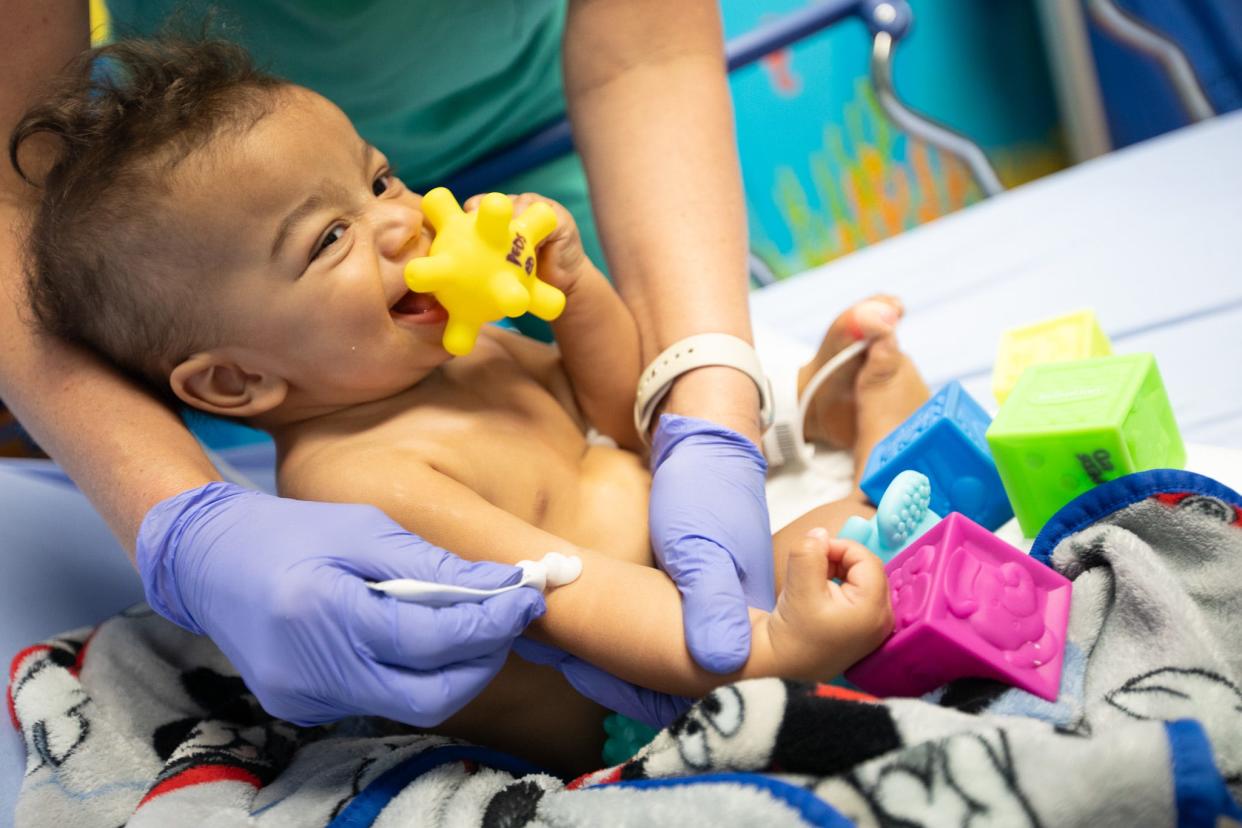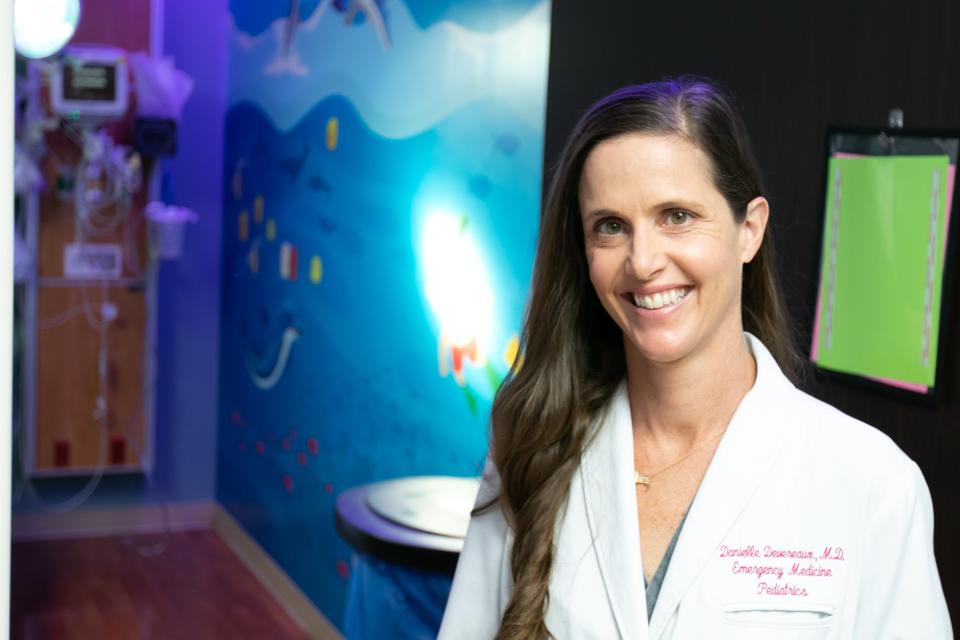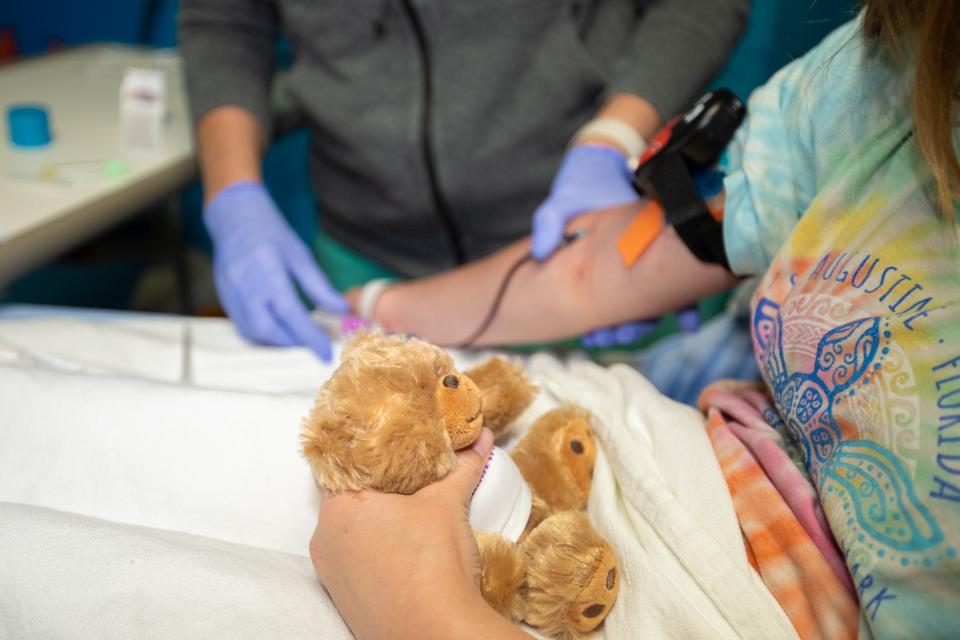Are your kids scared of needles? Health First helps remove pain, fear of getting a shot

Kimberlee McGregor of Cocoa brought her son Eli, 10 months, into the Pediatric Emergency Department (PED) at Health First’s Holmes Regional Medical Center on a recent morning because he was congested and resisting feeding for too long, a fact that in an infant may precipitate a course of IV fluids.
But the mother of five passed over nearer hospitals and urgent cares to arrive at this under-the-sea-themed PED because it’s so much more positive and relaxed.
“It’s a lot better here. They’re very interactive with the kids," she said. "They play, and that helps comfort them. Like, they’re not strangers, you know?”
Four doors down, Emily Silva of Satellite Beach sat in a chair beside her daughter Jasmine, 11. “You’re going to need an IV again,” Silva said. “It’s a needle that stays in, but it’s not really a needle. It’s plastic.”
“It’s one of those. It’s horrible.”
A survey of hospitalized children found that the worst pain they reported feeling during their stays was needle sticks — shots, blood draws or intravenous lines.
“Needles scare you?” asked Nurse Katie Kennedy, reaching for a ladybug-looking device. “We have some tricks for that.”
A generation or two ago, children were told to brace, be brave, buck up and bear it. Doctors and scientists have begun to question this approach and the underlying assumption that temporary pain or a fear of needles should not merit pain management.
“We can’t take away all of the discomfort, but we certainly can make it better,” said Dr. Danielle Devereaux, Medical Director of the PED, “and here, we put as much effort into making this a positive experience as we do into providing fast, emergency care for sick and injured babies and kids.”

Between the pain and the brain
“The first thing we can do is spray your arm with this,” Kennedy told Jasmine, holding an aerosol spray bottle of ethyl chloride, common for minor sports injuries or to prevent pain from injections.
“This makes your skin take a nap,” she said.
“Oh, no! I hate it when my leg falls asleep,” Jasmine said.
In the PED, just about all needle sticks are preceded by topical lidocaine and/or numbing spray. The local anesthetic can’t penetrate to all of the nerves that signal a stick, though, and that’s where Buzzy comes in.
“He’s kinda cute,” Jasmine said.

Simply by straddling the arm between the pain and the brain, the device jams the signals, what the manufacturer calls “gate control” pain relief.
Infants, toddlers and children are never constrained during a stick.
“It’s always hugs, not holds,” Dr. Devereaux said. For breast-fed babies, the best hold is often breastfeeding.
Finally, the nurses station and individual rooms are brimming with toys like games, stuffed animals, blocks and handheld bubble machines and whirling neon pinwheels. Sometimes two nurses are involved in placing an IV – one for the duty and one for the show.
After Nurse Kennedy strapped Buzzy to Jasmine’s arm, she poked her forearm up and down with a dull tool. “Feel that?”
“I can’t,” Jasmine said. “Weird! Really weird.”
Adults who skip preventive medicine
One authority estimates over the course of a healthy life the total number of needle sticks may land around 165.
“I think all kids freak out, and why wouldn’t they?” McGregor said. “I don’t like needles even now.”
Children who develop intense anxiety around “jabs” often become adults who avoid doctors’ appointments and shots of any kind — such as seasonal flu and COVID-19 vaccinations. It’s estimated that fear of needles affects up to 25% of adults, and may lead 16% of people in the US to skip vaccinations.
“Vaccinations save lives,” Dr. Devereaux said. “We don’t want to contribute to a culture of needle phobia that may cause a child not to receive future vaccinations.”
Extreme fear of needles has a medical diagnosis — trypanophobia — but less significant fear of needles can still cause significant medical or emotional harm. Some patients report feeling panic or losing sleep ahead of doctor’s appointments. Dr. Devereaux says the work her unit does to ease anxiety “aims to empower kiddos and parents to take control of their health.”
“There’s been emerging literature that shows even newborns experience pain, and this can alter their brain chemistry leading to chronic pain issues in the future. We apply principles of atraumatic care to even our tiniest patients.”
Asked after her IV was placed if she felt anything, Jasmine said, yes, she did.
“If I’m being totally honest, I could still feel it, but I wasn’t paying any attention.”
Health First’s Pediatric Emergency Department at Health First’s Holmes Regional Medical Center opened in 2020 and was developed in partnership with AdventHealth for Children in Orlando, and made possible by philanthropic support from the community through the Health First Foundation.
Bobby Ampezzan is Health First's Lead for External Communications.
This article originally appeared on Florida Today: Health First helps remove fear of needles from it's youngest patients

